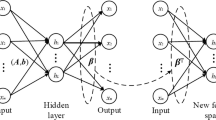Abstract
Extreme learning machine (ELM) is a popular method in machine learning with extremely few parameters, fast learning speed and model efficiency. Unsupervised feature learning based ELM receives rising research focus. Recently the ELM auto-encoder (ELM-AE) was proposed for this task, which develops the ELM based compact feature learning without sacrificing elegant solution. Compared with ELM-AE and following \(\ell _1\)-regularized ELM-AE, we introduce a sparse Bayesian learning scheme into ELM-AE for better generalization capability. A parallel training strategy is also integrated to improve time-efficiency of multi-output sparse Bayesian learning. Furthermore, pruning hidden nodes for better performance and efficiency according to estimated variances of prior distribution of output weights is achieved. Experiments on several datasets verify the effectiveness and efficiency of our proposed ELM-AE for unsupervised feature learning, compared with PCA, NMF, ELM-AE and \(\ell _1\)-regularized ELM-AE.








Similar content being viewed by others
References
Rumelhart DE, Hinton GE, Williams RJ et al (1988) Learning representations by back-propagating errors. Cognit Model 5(3):1
Huang G-B, Chen L, Siew CK et al (2006) Universal approximation using incremental constructive feedforward networks with random hidden nodes. IEEE Trans Neural Netw 17(4):879–892
Huang G-B, Zhou H, Ding X, Zhang R (2011) Extreme learning machine for regression and multiclass classification. IEEE Trans Syst Man Cybern Part B (Cybernetics) 42(2):513–529
Huang G-B, Zhu Q-Y, Siew CK (2006) Extreme learning machine: theory and applications. Neurocomputing 70(1–3):489–501
Nizar AH, Dong ZY, Wang Y (2008) Power utility nontechnical loss analysis with extreme learning machine method. IEEE Trans Power Syst 23(3):946–955
You ZH, Lei YK, Zhu L, Xia J, Wang Bing (2013) Prediction of protein-protein interactions from amino acid sequences with ensemble extreme learning machines and principal component analysis. Bmc Bioinform 14(S8):S10
Zhige Xie X, Kai SW, Liu L, Xiong Y, Hui Huang (2015) Projective feature learning for 3D shapes with multi-view depth images. Comput Graphics Forum 34(7):1–11
Huang G, Song S, Gupta JND, Cheng W (2014) Semi-supervised and unsupervised extreme learning machines. IEEE Trans Cybern 44(12):2405–2417
Kasun LLC, Zhou H, Huang G-B, Vong CM (2013) Representational learning with extreme learning machine for big data. IEEE Intell Syst 28(6):31–34
Kasun LLC, Yang Y, Huang G-B, Zhang Z (2016) Dimension reduction with extreme learning machine. IEEE Trans Image Process 25(8):3906–3918
Liyanaarachchi LCC, Tianchi L, Yan Y, Zhiping L, Guang-Bin H (2015) Extreme learning machine for clustering. In: Proceedings of ELM-2014, volume 1. Springer, pp 435–444
Tang J, Deng C, Huang G-B (2015) Extreme learning machine for multilayer perceptron. IEEE Trans Neural Netw Learn Syst 27(4):809–821
Luo J, Vong C-M, Wong P-K (2013) Sparse bayesian extreme learning machine for multi-classification. IEEE Trans Neural Netw Learn Syst 25(4):836–843
Hoerl AE, Kennard W (1970) Ridge regression: biased estimation for nonorthogonal problems. Technometrics 12(1):55–67
Huang G-B (2014) An insight into extreme learning machines: random neurons, random features and kernels. Cognit Comput 6(3):376–390
Ding C, He X (2004) K-means clustering via principal component analysis. In: International Conference on machine learning
Pearson K (1901) Liii. on lines and planes of closest fit to systems of points in space. Lond Edinb Dublin Philos Mag J Sci 2(11):559–572
Hotelling H (1933) Analysis of a complex of statistical variables into principal components. J Educ Psychol 24(6):417
Yoo Y, Oh S-Y (2016) Fast training of convolutional neural network classifiers through extreme learning machines. In: 2016 International Joint Conference on neural networks (IJCNN). IEEE, pp 1702–1708
Wang Y, Xie Z, Kai X, Dou Y, Lei Yuanwu (2016) An efficient and effective convolutional auto-encoder extreme learning machine network for 3d feature learning. Neurocomputing 174:988–998
Low C-Y, Teoh AB-J (2017) Stacking-based deep neural network: Deep analytic network on convolutional spectral histogram features. In: 2017 IEEE International Conference on Image Processing (ICIP). IEEE, pp 1592–1596
Congdon P (2007) Bayesian statistical modelling, vol 704. Wiley, Hoboken
Soria-Olivas E, Gomez-Sanchis J, Martin JD, Vila-Frances J, Martinez M, Magdalena JR, Serrano AJ (2011) Belm: Bayesian extreme learning machine. IEEE Trans Neural Netw 22(3):505–509
Bishop CM (2006) Pattern recognition and machine learning. Springer, Berlin
MacKay DJC (1992) The evidence framework applied to classification networks. Neural Comput 4(5):720–736
Nabney IT (2004) Efficient training of RBF networks for classification. Int J Neural Syst 14(3):1–8
Tipping ME (2001) Sparse Bayesian learning and the relevance vector machine. J Mach Learn Res 1(Jun):211–244
MacKay DJC (1992) Bayesian interpolation. Neural Comput 4(3):415–447
Abadi M, Agarwal A, Barham P, Brevdo E, Chen Z, Citro C, Corrado GS, Davis A, Dean J, Devin M et al (2016) Tensorflow: Large-scale machine learning on heterogeneous distributed systems. arXiv preprint arXiv:1603.04467
Lee DD, Sebastian Seung H (1999) Learning the parts of objects by non-negative matrix factorization. Nature 401(6755):788
Michael L, Akamatsu S, Kamachi M, Gyoba J (1998) Coding facial expressions with gabor wavelets. In: Proceedings Third IEEE international conference on automatic face and gesture recognition, pp 200–205. IEEE
Samaria FS, Harter AC (1994) Parameterisation of a stochastic model for human face identification. In: Proceedings of 1994 IEEE Workshop on Applications of Computer Vision. IEEE, pp 138–142
Kazemi V, Sullivan J (2014) One millisecond face alignment with an ensemble of regression trees. In: IEEE Conference on computer vision and pattern recognition
Author information
Authors and Affiliations
Corresponding author
Additional information
Publisher's Note
Springer Nature remains neutral with regard to jurisdictional claims in published maps and institutional affiliations.
Rights and permissions
About this article
Cite this article
Zhang, G., Cui, D., Mao, S. et al. Unsupervised feature learning with sparse Bayesian auto-encoding based extreme learning machine. Int. J. Mach. Learn. & Cyber. 11, 1557–1569 (2020). https://doi.org/10.1007/s13042-019-01057-7
Received:
Accepted:
Published:
Issue Date:
DOI: https://doi.org/10.1007/s13042-019-01057-7




